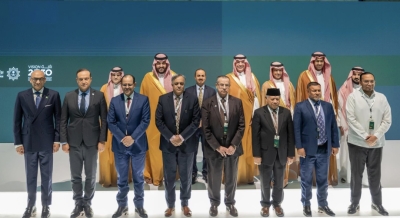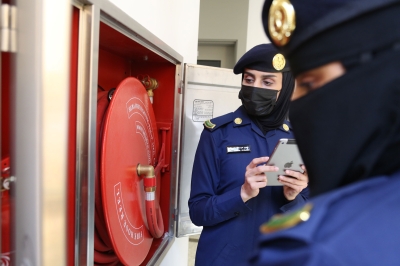


Crescent Moon Sighting in the Kingdom of Saudi Arabia is the process of examining and monitoring the start of the Hijri months in the Kingdom according to the lunar calendar. The Supreme Court oversees this process and ensures sighting reliability through a number of guarantees, including the medical criteria for assessing the visual acuity of moon sighters. In sighting the crescent moon, the Kingdom relies on both visual sighting and astronomical observatories in locations suitable for crescent sightings during the specified times after sunset on the twenty-ninth day of the lunar month.
Crescent moon sighting mechanism in Saudi Arabia
The Supreme Court delegates judges to sighting sites at observatories located across the Kingdom, under the supervision of King Abdulaziz City for Science and Technology (KACST), and with the participation of several specialists in astronomy and crescent moon monitoring. Sighting sites are chosen through several criteria to enable an accurate sighting process.
The Kingdom is concerned with the crescent moon sighting process due to its connection to Muslim worship. This task was entrusted to the Supreme Court, which ensures the reliability of the sightings through several criteria, including the medical criteria. Moon sighters undergo a rigorous examination and a medical test to examine visual acuity. Subsequently, their documents are presented to the permanent supervisory committee for crescent moon sighting at the Ministry of Justice, which was approved by Royal Order, and its activities are supervised by the Minister of Justice.
The sighting takes place post-sunset on the twenty-ninth day of the Hijri lunar month. Should the crescent moon be sighted after sunset on the twenty-ninth day, even by a mere minute, the month becomes shorter, comprising only twenty-nine days. Consequently, that night is considered part of the subsequent month.
Criteria for selecting observatory sites
KACST provided observatories across a number of provinces in the Kingdom. Some are fixed, such as Umm al-Qura Observatory in Makkah al-Mukarramah, and
Judges are delegated to accompany sighters at sighting sites in observatories throughout the Kingdom, supervised by KACST, with the participation of specialists in crescent moon sighting and professionals with a Ph.D. in astronomy, along with representatives of government entities, while carefully choosing the locations of these observatories.
Monitoring equipment in astronomical observatories
KACST astronomical observatories employ devices equipped with modern technologies, telescopes, CCD binoculars, and thermal cameras. They work with the Astronomical Center at Majmaah University in Hawtat Sudayr and the modern observatory at the Clock Towers in Makkah al-Mukarramah to monitor the crescent moon. These observatories are linked to the Supreme Court via live video streaming during the course of the session when the monitoring and sighting process begins. On the other hand, the specialized team prepares reports on the moon’s conditions.
The Supreme Court monitors technical crescent moon observation from an early stage on sighting days, alongside astronomical and mathematical reports issued by government entities regarding the new moon, sunset and moonset times, moonrise, moon position, and weather conditions in each monitoring area to determine whether the sighting is possible. The sighter's testimony will not be accepted unless it has been discussed by the permanent supervisory committee for crescent sighting at the Ministry of Justice to verify the accuracy of the sighting before announcing it.
History of crescent moon sighting in Saudi Arabia
The organization of the first official calendar in the Kingdom dates back to the era of King Abdulaziz Bin Abdulrahman Al Saud when he ordered the printing of the book 'Calendar of Times for the Sighting in Najd' and 'Calendar of Times for the Sighting in the Kingdom.' These two books are the first building blocks for the Kingdom's calendar. They were merged with Umm al-Qura Calendar, with its first issue published in 1927.
During the reign of King Abdulaziz, Sheikh Mohammed Abdul Razzaq Hamza, (former) teacher at the Grand Mosque, requested the establishment of an astronomical observatory atop Mount Abu Qubays in Makkah al-Mukarramah, to utilize its equipment to confirm crescent moon sightings for the months of Ramadan and Dhu al-Hijjah. The request was presented to King Saud Bin Abdulaziz Al Saud (the Crown Prince at the time). He issued an order to the Ministry of Finance on July 29, 1948, to build a special room for the observatory on the summit of Mount Abu Qubays, marking the first astronomical observatory in Makkah al-Mukarramah. King Saud also offered him some astronomical observation instruments. These included a theodolite, a device used to measure the angles of celestial bodies both horizontally and vertically; an astronomical telescope; and a chronometer watch used on ships and installed in two wooden boxes to prevent the effects of movement and vibration. This comes in addition to a barometer for measuring the altitude of natural features, such as mountains, deserts, and plateaus above sea level, and a sextant, a device used on ships to precisely measure the angle between the horizon and celestial bodies like planets, stars, the sun, and the moon in degrees, minutes, and seconds.
Several astronomy enthusiasts emerged from among the students of Sharia sciences during the reign of King Abdulaziz, such as: Sheikh Hamad Bin Rumaih who traveled to many countries to seek knowledge and excelled in the Sharia sciences, the Arabic language, and astronomy. Moreover, he was a reference for the people of Najd in this field. Others include Sheikh Abdullah al-Khulaifi who wrote a manuscript on astronomy, and Sheikh Saleh Bin Sahman who wrote a book entitled 'The Innovative, Clear, and Comprehensive Calendar.'
In 1983, the Council of Senior Scholars authorized the use of astronomical observatories and defined the difference between the lunar month according to Islamic scholars and mathematical scholars. The research was published in the Council's research volume in 2013. Additionally, the Council of Ministers issued a regulation in December 1997 for the sighting of the crescent moon to mark the beginning of lunar months.
Astronomical observatory at Majmaah University
It is located in Hawtat Sudayr center, affiliated with al-Majma'ah Governorate, Riyadh Province. It stemmed from the inception of a specialized scientific founding committee tasked with developing a comprehensive vision for the observatory, taking into account the scientific, administrative, and technical aspects, as well as the trends of local and international astronomical observatories. The contents of the observatory vary between a refracting astronomical telescope equipped with a charge-coupled device (CCD) to observe celestial bodies, and two planetariums screening astronomical films dubbed in Arabic and English.
Astronomical observatory in Tumair
It is located in Tumair center at al-Majma'ah Governorate, Riyadh Province. The transition from the old observatory to the new one, established in 2015, was under the supervision of the Tumair Municipality. The new Tumair observatory is located to the west and is surrounded by rocky areas where dirt or dust does not arise. It is 658 m above sea level.
Related quizzes

